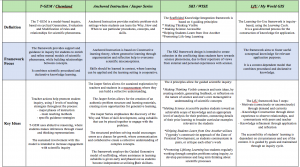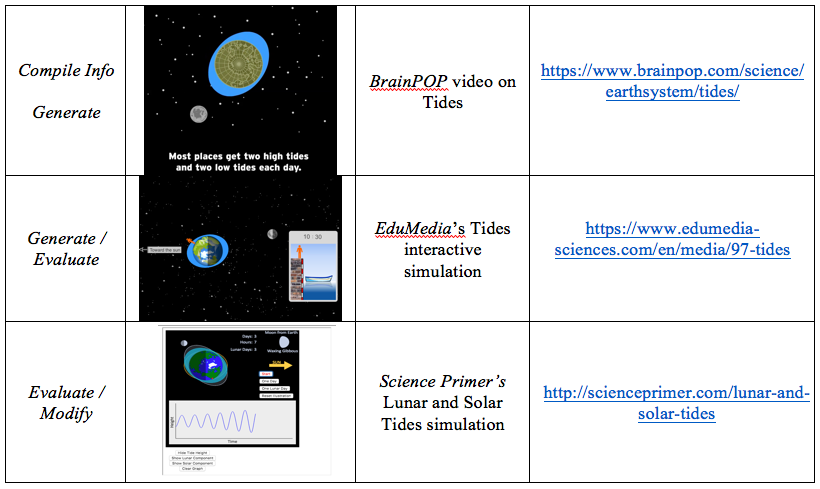The concept of information-visualization allows for students to visualize and make sense of conceptual understandings that are not easy to grasp, either due to the minuscule size (of atoms, for example), or the lack of tangible familiarity, such as fractions being parts of a whole. Where children experience their three-dimensional world on a regular basis as a concrete experience, rather than a conceptualized environment, spatial reasoning, relationship-building with the physical world and information-visualization are key components to develop at a young age. Jones and Mooney point out that “physical experience, especially the physical manipulation of shapes, is important at all ages”, particularly through geometrical experiences to build “a firm understanding of geometrical relationships” (Jones, K., Mooney, C., 2003). Although computer simulations are not the be-all, end-all for learning about geometry and visualizing difficult concepts in the physical world, Finkelstein et al. highlight the many benefits of using computer software and applications to simulate geometric environments, “providing simulations are properly designed and applied to the appropriate contexts” (Finkelstein, N.D. et al., 2005).
In my own context, I have found that in the lower intermediate grades, students have difficulty grasping fractions. Physical models of fraction circles help them to understand that a quarter of a pizza is not comparable to half an apple, but when it comes to finding and comparing equivalent fractions, they need more opportunities to play around with the numbers that they see on the page and apply it to something tangible, more concrete in their minds. Therefore, the example below is of a lesson using the Learning for Use model, where students are introduced to equivalent fractions using a card game I’ve been teaching with for many years. However, I have enhanced the game to include Knowledge construction activities using Illuminations’ app for Equivalent Fractions. Students have plenty of opportunities to ‘play around’ with different fractions to improve their visualizations of what equivalent fractions mean.
Understanding Equivalent Fractions
Goal: Students will be able to visually represent equivalent fractions.
Materials:
- Laptops
- Illuminations app: Equivalent Fractions – http://illuminations.nctm.org/Activity.aspx?id=3510
Lesson based on LfU model:
Motivate:
- Students are introduced to the game ‘Fraction Wars’, a card game where students flip over two cards (A=1, to 10), placing them one above the other to create a fraction. Whoever has the higher fraction collects all the cards. Students may also experience a draw, known as ‘war’. This applies to equivalent fractions. When ‘war’ is declared, students flip another two cards, until there is a winner who collects all the cards. The student with the most cards at the end wins.
- To properly identify a ‘war’ situation, students need to be able to understand, identify and compare equivalent fractions. Students will play a class-vs-teacher round until war is declared.
Knowledge construction:
- In the event of a war, students must illustrate, using drawings or objects, how the fractions are equivalent, bigger or smaller.
- Students will share their explanations in table groups. When the group has a consensus, they will place their hands on their heads. Allow 5-10 minutes if a group has not yet reached consensus.
- Hand out laptops and have students go to the Illuminations site – Equivalent Fractions app.
- Students work to identify equivalent fractions of the computer-given fraction, using Illuminations.
- Students build their own equivalent fractions to build understanding, using Illuminations.
- Students compare different fractions and discuss with each other which fractions are deemed larger or smaller. What is their proof?
- Students may recreate physical or drawn models to further illustrate their proof of equivalent, larger or smaller fractions.
Knowledge Refinement:
- Students return to teacher example and share consensus, using their model as proof.
- Students play Fraction Wars against each other, regulating the game based on their refined understandings of fractions, with models or Illuminations to help in their visualizations.
References:
Finkelstein, N.D., Perkins, K.K., Adams, W., Kohl, P., & Podolefsky, N. (2005). When learning about the real world is better done virtually: A study of substituting computer simulations for laboratory equipment. Physics Education Research,1(1), 1-8.
Jones, K. and Mooney, C. (2003). Making Space for Geometry in Primary Mathematics. In: I. Thompson (Ed), Enhancing Primary Mathematics Teaching. London: Open University Press. pp 3-15.


